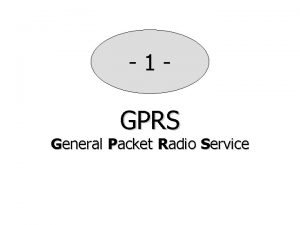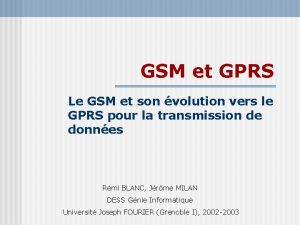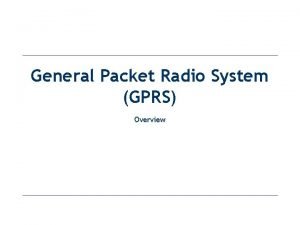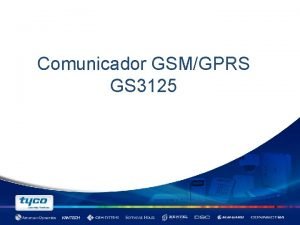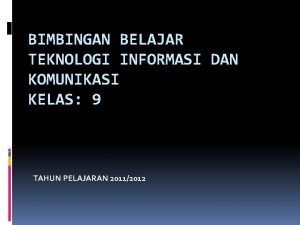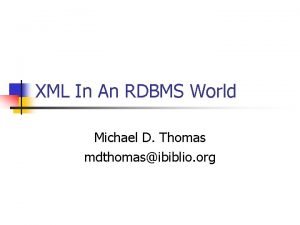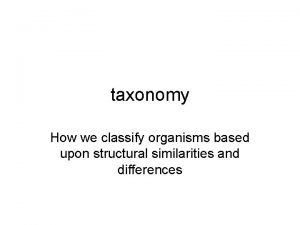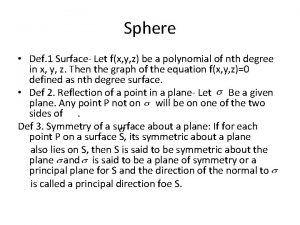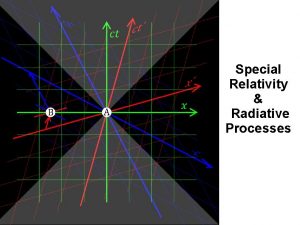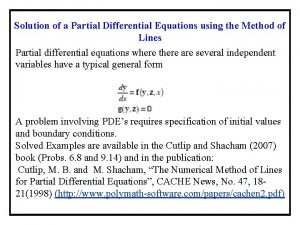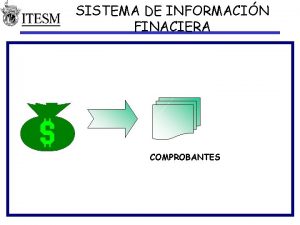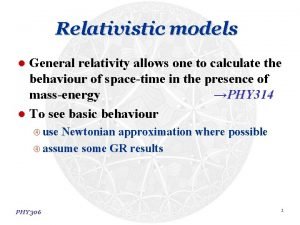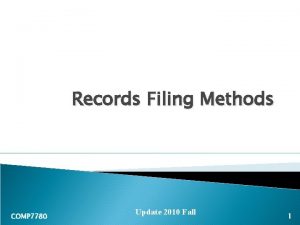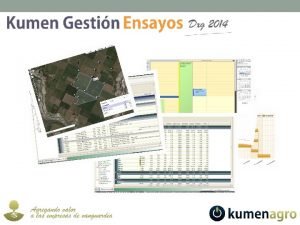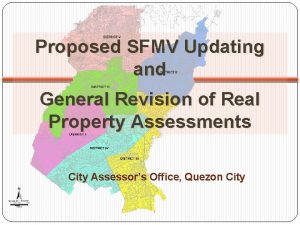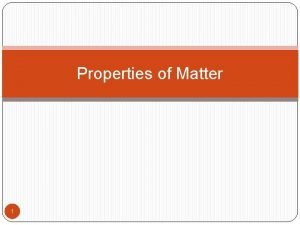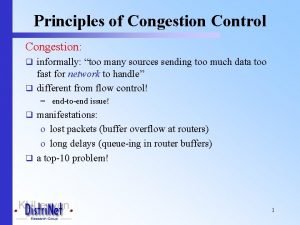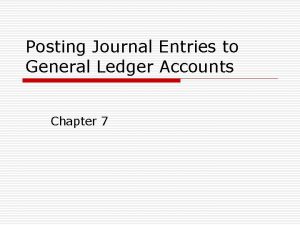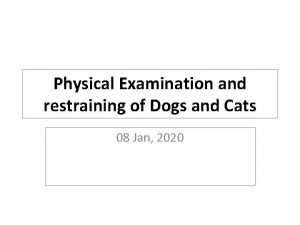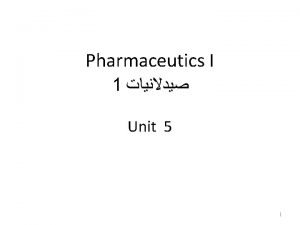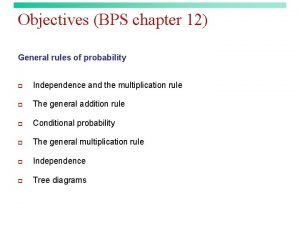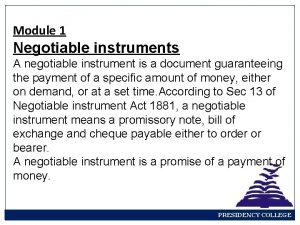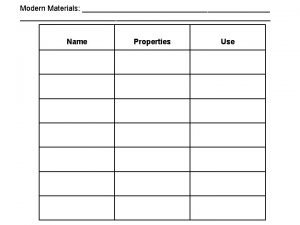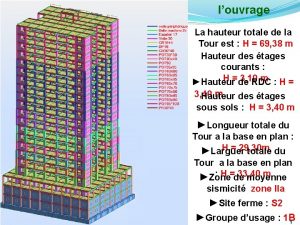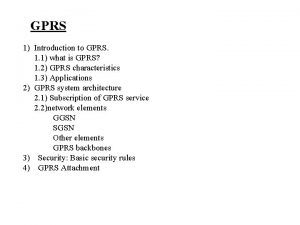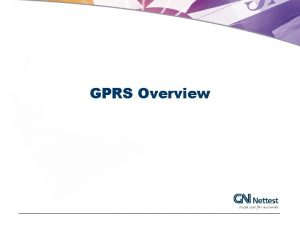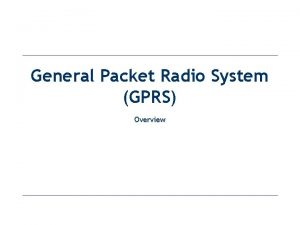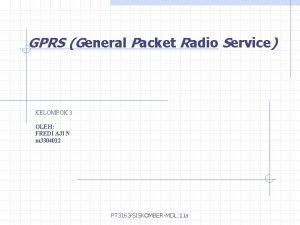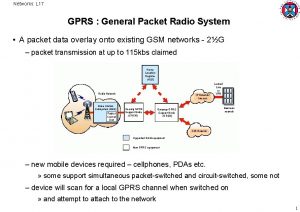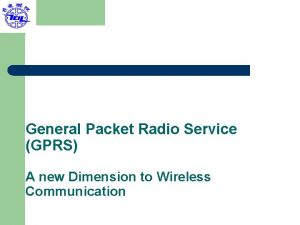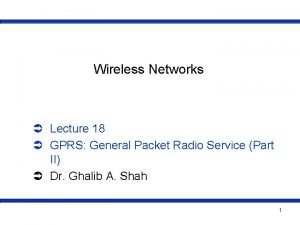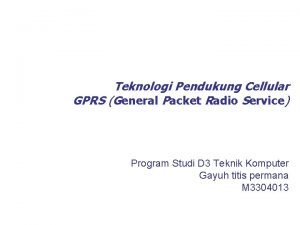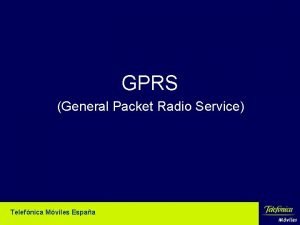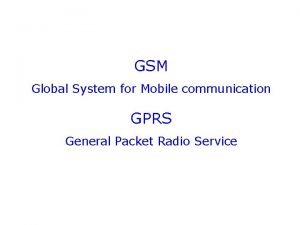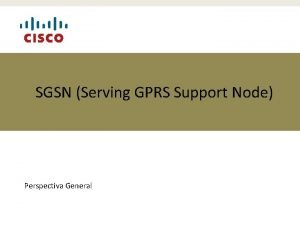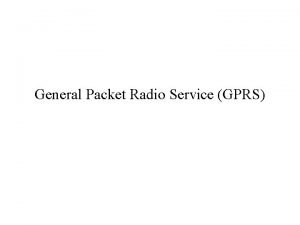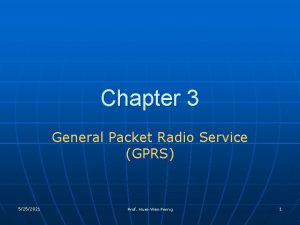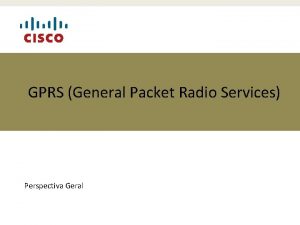Introduction to GPRS 1 o GPRS n General



















![o GPRS phase 2 implementation n 加強GPRS的Qo. S支援 n 無格式化位元組資料流(unstructured octet [八位 元組] stream)的GPRS o GPRS phase 2 implementation n 加強GPRS的Qo. S支援 n 無格式化位元組資料流(unstructured octet [八位 元組] stream)的GPRS](https://slidetodoc.com/presentation_image_h/8fb5b5dd02da668298588da09021c519/image-20.jpg)

















![o Case 3:GPRS手機與PDN上的PC n [步驟 1] MS首先會做GPRS-attached,以開始� 動GPRS的服務,此後MS與SGSN建立起一個 session o Case 3:GPRS手機與PDN上的PC n [步驟 1] MS首先會做GPRS-attached,以開始� 動GPRS的服務,此後MS與SGSN建立起一個 session](https://slidetodoc.com/presentation_image_h/8fb5b5dd02da668298588da09021c519/image-38.jpg)

![n [步驟 3] GGSN 1向DHCP server要到一個IP address,透過SGSN 1送給MS,建立起PDP context o 註:DHCP (Dynamic Host Configuration n [步驟 3] GGSN 1向DHCP server要到一個IP address,透過SGSN 1送給MS,建立起PDP context o 註:DHCP (Dynamic Host Configuration](https://slidetodoc.com/presentation_image_h/8fb5b5dd02da668298588da09021c519/image-40.jpg)




![透過APN存取GPRS Service的步驟 o [步驟一] 使用者�動一個 service,MS會送 request給SGSN o [步驟二] SGSN比較HLR中的用戶資料,檢 �此 service是否有授權給該user o [步驟三] 透過APN存取GPRS Service的步驟 o [步驟一] 使用者�動一個 service,MS會送 request給SGSN o [步驟二] SGSN比較HLR中的用戶資料,檢 �此 service是否有授權給該user o [步驟三]](https://slidetodoc.com/presentation_image_h/8fb5b5dd02da668298588da09021c519/image-45.jpg)
![o [步驟四] 如果在local DNS找不到APN相對應 的IP address n case 1:user在自己的home network,此request會 被拒� n case 2:user在foreign o [步驟四] 如果在local DNS找不到APN相對應 的IP address n case 1:user在自己的home network,此request會 被拒� n case 2:user在foreign](https://slidetodoc.com/presentation_image_h/8fb5b5dd02da668298588da09021c519/image-46.jpg)


















































































































- Slides: 160

Introduction to GPRS


1. 簡介 o GPRS n General Packet Radio Service n 一般封包式無線電服務 o GPRS標準 n 制訂於 1994年 n 制訂單位ETSI/SMG (European Telecommunications Standards Institute / Special Mobile Group) n 主要內容於 1997年由SMG#25通過 n 完成於 1999年



Circuit Switched vs. Packet Switched Circuit Switched Packet Switched

Circuit and Packet Support


o 設計GPRS協定時,盡可能讓channel的配置 有彈性,以增加系統容量 n 以timeslot為基本傳送packet的單位,最多可將同 一carrier的8個timeslots都分配給同一個MS n 手機傳送封包的channel o 以符合像web、file transfer之asymmetric flow 的特性,分別分配uplink與downlink的channel n 提供fast reservation,可在 0. 5到 1 sec�動資料傳 輸

n 四種channel coding schemes (CS 1、CS 2、CS 3、 CS 4) o CS 1 n user data rate: 9. 05 Kbps n correction capability:highest n max cell range: 450 m o CS 2 n user data rate: 13. 4 Kbps n max cell range: 390 m

o CS 3 n user data rate: 15. 6 Kbps n max cell range: 350 m o CS 4 n user data rate: 21. 4 Kbps n max cell range: 290 m n correction capability:none

o 安全機制:GPRS與GSM相同 o 編碼演算法:GPRS調整GSM編碼演算法以 適合packet data的傳輸 o GPRS系統方面 n GPRS元件中由舊的GSM元件加以修改(software upgrade)而得 o MS、BSS、MSC/VLR、HLR o 例如:HLR會加上GPRS subscriber information



TRAU:Transcoder and Rate Adaptation Unit

1. 2 GPRS Implementation o GPRS phase 1 implementation n 標準封包傳送服務(point to point packet bearer service) n 達成CS-1及CS-2通道編碼技術 n 建置下列介面 o Gn (SGSN ↔ SGSN) o Gb (SGSN ↔ BSS) o Gp (SGSN ↔ GGSN (other PLMN)) o Gs (SGSN ↔ MSC/VLR)

n 彈性的無線電資源配置 n Class B與Class C手機的規範 o Class A:上網時可同時接聽電話 n can be connected to GPRS service and GSM service (voice, SMS), using both at the same time n such devices are known to be available today o Class B:上網時不可同時接聽電話 n can be connected to GPRS service and GSM service (voice, SMS), but using only one or the other at a given time n during GSM service (voice call or SMS), GPRS service is suspended, and then resumed automatically after the GSM service (voice call or SMS) has concluded n most GPRS mobile devices are Class B

o Class C:只可上網不可接聽電話 n are connected to either GPRS service or GSM service (voice, SMS) n must be switched manually between one or the other service n n GPRS計費,如以封包計費及Qo. S計費 提供靜態及動態IP address配置 匿名存取(anonymous access) 安全性(security)

![o GPRS phase 2 implementation n 加強GPRS的Qo S支援 n 無格式化位元組資料流unstructured octet 八位 元組 stream的GPRS o GPRS phase 2 implementation n 加強GPRS的Qo. S支援 n 無格式化位元組資料流(unstructured octet [八位 元組] stream)的GPRS](https://slidetodoc.com/presentation_image_h/8fb5b5dd02da668298588da09021c519/image-20.jpg)
o GPRS phase 2 implementation n 加強GPRS的Qo. S支援 n 無格式化位元組資料流(unstructured octet [八位 元組] stream)的GPRS PDP (Packet Data Protocol) type n 對ISP及Intranet的接取 n GPRS預付機制(prepaid)

n GPRS收費建議(Advice of Charge,Ao. C)機制 o Ao. C service provides the mobile subscriber with an estimate of the call charges o two types of Ao. C information n provides the subscriber with an estimate of the bill n used for immediate charging purposes (hot billing) n 群體通話(point-to-multipoint services) n 點對多點的multicast服務



Logical Architecture:Interfaces 註:公 眾 行 動 電 話 網 路 (Pulbic Land Mobile Network, PLMN)

o 在此GPRS網路內,GSM定義一種新的邏輯 網路節點 n GPRS支援節點(GPRS Support Node,GSN) o GSN依其負責的功能劃分 n GPRS服務支援節點(Serving GPRS Support Node, SGSN) n GSN閘道(Gateway GPRS Support Node,GGSN)


o GPRS attach n SGSN會為MS建立一個MM context (關於MS的 mobility及security) o PDP context activation n SGSN會為每個session建立一個PDP context用於 儲存轉送封包等資訊










![o Case 3GPRS手機與PDN上的PC n 步驟 1 MS首先會做GPRSattached以開始 動GPRS的服務此後MS與SGSN建立起一個 session o Case 3:GPRS手機與PDN上的PC n [步驟 1] MS首先會做GPRS-attached,以開始� 動GPRS的服務,此後MS與SGSN建立起一個 session](https://slidetodoc.com/presentation_image_h/8fb5b5dd02da668298588da09021c519/image-38.jpg)
o Case 3:GPRS手機與PDN上的PC n [步驟 1] MS首先會做GPRS-attached,以開始� 動GPRS的服務,此後MS與SGSN建立起一個 session

![n 步驟 3 GGSN 1向DHCP server要到一個IP address透過SGSN 1送給MS建立起PDP context o 註DHCP Dynamic Host Configuration n [步驟 3] GGSN 1向DHCP server要到一個IP address,透過SGSN 1送給MS,建立起PDP context o 註:DHCP (Dynamic Host Configuration](https://slidetodoc.com/presentation_image_h/8fb5b5dd02da668298588da09021c519/image-40.jpg)
n [步驟 3] GGSN 1向DHCP server要到一個IP address,透過SGSN 1送給MS,建立起PDP context o 註:DHCP (Dynamic Host Configuration Protocol)

GPRS手機與PDN上的PC DHCH Server


o 在Internet上,DNS server會把domain name轉 成IP address,在GPRS network上的DNS server,會將此APN轉成GGSN的IP address

![透過APN存取GPRS Service的步驟 o 步驟一 使用者動一個 serviceMS會送 request給SGSN o 步驟二 SGSN比較HLR中的用戶資料檢 此 service是否有授權給該user o 步驟三 透過APN存取GPRS Service的步驟 o [步驟一] 使用者�動一個 service,MS會送 request給SGSN o [步驟二] SGSN比較HLR中的用戶資料,檢 �此 service是否有授權給該user o [步驟三]](https://slidetodoc.com/presentation_image_h/8fb5b5dd02da668298588da09021c519/image-45.jpg)
透過APN存取GPRS Service的步驟 o [步驟一] 使用者�動一個 service,MS會送 request給SGSN o [步驟二] SGSN比較HLR中的用戶資料,檢 �此 service是否有授權給該user o [步驟三] SGSN向local GPRS DNS server�詢 負責此APN的GGSN的IP address
![o 步驟四 如果在local DNS找不到APN相對應 的IP address n case 1user在自己的home network此request會 被拒 n case 2user在foreign o [步驟四] 如果在local DNS找不到APN相對應 的IP address n case 1:user在自己的home network,此request會 被拒� n case 2:user在foreign](https://slidetodoc.com/presentation_image_h/8fb5b5dd02da668298588da09021c519/image-46.jpg)
o [步驟四] 如果在local DNS找不到APN相對應 的IP address n case 1:user在自己的home network,此request會 被拒� n case 2:user在foreign network,SGSN會向MS的 home network的DNS�詢 o [步驟五] 當找到GGSN的IP address n SGSN會藉助GTP (GPRS Tunneling Protocol)建立 起與GGSN間的tunnel

2. 7 MS IP Address Allocation o 要建立起MS與external network間的連結(PDP context),MS必須要有IP address o GPRS有兩種分配MS IP address的方式 n fixed addressing n dynamic addressing

o Fixed addressing n 永遠分配給MS相同的IP address,此IP address存 在HLR中 n 當MS想要開�一個 PDP context到某一個APN, HLR將IP address送到SGSN再送到MS n 此種方式是搶迫MS一定要使用network分配的IP address

o Dynamic addressing n 當MS開� PDP context時,GGSN會分配一個IP address,並透過SGSN傳送給MS n 當關閉PDP context時,SGSN收回此IP address

2. 8 GGSN取得IP Address的四種方 式 o 四種方式 n n from a local address pool on the GGSN via RADIUS form an external RADIUS server via DHCP from the customer network via an L 2 TP tunnel from the GGSN

o From a local address pool on the GGSN n 運作方式類似PSTN dialup server o GGSN有一個IP address pool o 當有MS需要IP,GGSN從pool分配一個IP給 MS n 如客戶端選擇由operator分配IP,這是所有方式 中最簡單的方式

o Via RADIUS form an external RADIUS server n 通常RADIUS server會在customer network n RADIUS server認證user terminal,給予一個fixed IP address o 註:RADIUS (Remote Access Dial In User Service) Protocol n 提供authentication機制,用來辨認使用者的身份與密碼 n 確認通過後,經由authorization授權使用者登入網域使用 相關資源 n 提供accounting機制,保存使用者的網路使用記錄,以提 供系統服務業者完整認證收費機制的一個基礎

o Via DHCP n GGSN向DHCP server要一個IP address n 可把DHCP server設定成fixed IP address,則MS 每次都會取得相同的IP address

o From the customer network via an L 2 TP tunnel from the GGSN n L 2 TP是Layer 2的tunneling protocol o 通常用於PSTN dial-up到一個Remote Access Server n 對GPRS而言,L 2 TP在GGSN與customer network 的router間建立一個安全的連結

Footnote:Layer 2 Tunneling Protocol (L 2 TP) o A tunneling protocol used to support virtual private networks (VPNs) o It does not provide any encryption or confidentiality by itself; it relies on an encryption protocol that it passes within the tunnel to provide privacy o Although L 2 TP acts like a Data Link Layer protocol in the OSI model, L 2 TP is in fact a Session Layer protocol

2. 9 GPRS Billing

o GPRS的計費資訊是由SGSN及GGSN收集 n SGSN收集MS的radio resource usage n GGSN收集MS的network usage n 如MS到其它GPRS network使用資源 o 若到訪的GPRS network使用dynamic address 連到MS,則計費資料會送到home GPRS network

o SGSN所搜集的計費相關資訊 n location information o 指出MS是在home network還是在visited network o cell location n mobile origination及mobile termination的資料傳輸量 o 資料量在SGSN的SNDCP (Sub Network Dependent Convergence Protocol) level測得 n 使用者指定的Qo. S profile n 使用的通訊協定

o GGSN所搜集的計費相關資訊 n destination和source的addresses n MS與external data network間所使用的資料傳輸 量(資料量在GGSN的GTP level所測得) n MS使用到PDP address的整段時間

Call Detailed Records (CDRs) o SGSN與GGSN收集到的計費資料會轉成call detailed records (CDR) o Call detailed record分成 n S-CDR (SGSN PDP context generated-CDR) o 由SGSN�生,記錄 MS無線電資源的使用量 n G-CDR (GGSN generated-CDR) o 由GGSN�生,記錄 MS所使用GGSN的外部網路 n M-CDR (Mobility Management generated-CDR) o 由SGSN�生,記錄 MS行動管理的相關資料

o S-CDR的欄位包含 n mobile originating (MO) data volume:手機撥出 資料量 n mobile terminating (MT) data volume:手機接收 資料量 n location information:手機的位置資訊 n SMS MO:SGSN mobile originated SMS record n SMS MT:SGSN mobile terminated SMS record n associated Qo. S:相關的Qo. S資訊 n record duration:相關record存在SGSN中的時間

o G-CDR的欄位包含 n n n source address destination address 收到外部網路的資料量 送到外部網路的資料量 相關的Qo. S資訊 record duration:record存在GGSN中的時間

o 每位使用者的PDP context,會�生一個 CDR n �動 (activate) PDP context時,會開始�生相對 應的CDR n 每個PDP context可能�生數筆 S-CDRs及G-CDRs

o CDR可依下列三種方式�生 n end-of-call accounting schedule:通話結束時�生 n time-of-day accounting schedule:一天中的某時 刻�生 n inter-SGSN routing area update:跨SGSN RA (Routing Area)移動時�生 o 當手機在通訊狀態下移動到不同GSN,數個 CDRs可由不同的GSNs及外部資料網路�生


o Charging gateway function (CGF) n 控制charging data record (CDR)的收集 o CDR被送到GPRS Billing Mediation (調停) n 組成billing record,再送到billing system,做為 計費的依據

o GPRS的幾種billing方式 n flat-rate billing (ex:月租費 800元) n per-packet billing (ex: 0. 2元/128 kbytes) n volume-based billing (PDP activate到deactivate的 時間) n value-based billing (加�服務, depend on context)

o 影響上述rate的因素 n Quality of Service n time of day (如減價時段,off-peak time/peak time) n day of week (如weekend,weekday,holiday) n content, call type, services used (ex: 0204、圖形 下載) n source or destination (如國外電話,用戶是員 、 員警等屬性)

Billing by Quality of Service o Service precedence class o Reliability class n n n loss ratio (for each layer) out of order (失序率) corrupted ratio (誤碼率) duplicate ratio (重覆率) reliability (1 -5 levels) o Peak throughput class (吞吐量) o Mean throughput class o Delay class (傳輸延遲)

3. GPRS介面(Interface)

o GPRS架構於GSM上,盡可能不動原先GSM 的運作,除air interface及與SGSN、GGSN相 連的介面外,基本上都延用GSM的protocol o 新的protocol也都遵循GSM MAP架構 n n Gs (SGSN ↔ MSC/VLR) Gr (SGSN ↔ HLR) Gc (GGSN ↔ HLR) Gf (SGSN ↔ EIR)

3. 1 GPRS Transmission & Signaling Planes o GPRS延用OSI 7 -layer概念,每個interface定義的協定都 具layered structure o 使用的protocol stack分為 n transmission plane o 傳送使用者資料及與此資訊傳送相關的控制程序 o 例如:流量控制、錯誤偵測、更正與回覆 n signaling plane o 其它用於控制transmission plane functions所用到 的控制訊號

3. 1. 1 GPRS Transmission Plane

o GPRS protocol n 參考ISO/OSI (International Organization for Standardization/Open Systems Interconnection)架構所 建議的GPRS傳輸協定架構 o 在手機與終端主機的網路層之上,可根據應用程式需求, 採用不同協定 n 例如:在應用程式下可使用TCP (Transmission Control Protocol)來傳送,至於是架在X. 25或IP上, GPRS並不限制




3. 1. 2 GPRS Signaling Plane


o 在MS與SGSN間 n GMM/SM layer提供GPRS行動管理(GMM)及會 期管理(SM)功能 o SGSN↔GGSN之Gn interface與transmission plane的不同 n 只採用UDP傳送控制訊息

o GGSN↔HLR的Gc interface的MAP n 將GSM的MAP延伸成能支援GPRS行動管理的能 力 o SGSN↔MSC/VLR的Gs interface n 上層採用extended BSSAP,而非使用TCAP

3. 1. 2. 1 MS ↔ BSS o MS與BSS間實體層(physical layer) n 實體無線電子層(physical RF sub. Layer,RFL) o 負責GSM無線電相關規範,執行 modulation/demodulation n 實體連結子層(Physical Link sub. Layer,PLL) o 負責在實際連結上資訊的傳輸



Note:Aloha o A system for coordinating and arbitrating access to some shared communication channel o A medium access method is supposed to prevent two or more systems from transmitting at the time on a shared medium

o In the Aloha system n a station transmits whenever data is available to send n if another station transmits at the same time, a collision occurs and the frames that were transmitted are lost n however, a station can listen to broadcasts on the medium, even its own, and determine if the frames were transmitted

Aloha

o Slotted Aloha n distinct time slots are created in which systems can transmit a single frame n one system emits a signal at the start of each slot to let all other systems know when the slot is available n by aligning frames on slots, overlaps in the transmissions are reduced

n however, systems must wait a fraction of a second for the beginning of a time slot before they can transmit n also, data may be lost if stations contend for the same slot n tests have shown that slotted Aloha has a performance advantage

Slotted Aloha


Note:Selective ARQ o Automatic Repeat-re. Quest (ARQ) n an error control method for data transmission which uses acknowledgments and timeouts to achieve reliable data transmission o an acknowledgment is a message sent by the receiver to the transmitter to indicate that it has correctly received a data frame o a timeout is a reasonable point in time after the sender sends the data frame; if the sender does not receive an acknowledgment before the timeout, it usually re-transmits the frame until it receives an acknowledgment or exceeds a predefined number of re-transmissions

o Selective (Repeat) ARQ n a specific instance of the Automatic Repeat-re. Quest (ARQ) Protocol n it may be utilized as a protocol for the delivery and acknowledge of message units, or it may be utilized as a protocol for the delivery of subdivided message sub-units n the sending process continues to send a number of frames specified by a window size even after a frame loss n the receiving process will continue to accept and acknowledge frames sent after an initial error

n the receiver process keeps track of the sequence number of the earliest frame it has not received, and sends that number with every ACK it sends n if a frame from the sender does not reach the receiver, the sender continues to send subsequent frames until it has emptied its window n the receiver continues to fill its receiving window with the subsequent frames, replying each time with an ACK containing the sequence number of the earliest missing frame n once the sender has sent all the frames in its window, it resends the frame number given by the ACKs, and then continues where it left off

3. 1. 2. 2 BSS ↔ SGSN o NS (Network Service) n 利用下層frame relay建立起BSS與SGSN間的 virtual connection (NS-VC) n NS是在管理NS-VC以提供上層BSSGP傳送 BSSGP PDU

o 基地台GPRS協定(BSS GPRS Protocol, BSSGP) n 負責在BSS與SGSN間傳送路由與Qo. S資訊的 作, 並提供上層LLC傳遞的服務 n 在BSS上,BSSGP的relay function須提供RLC/MAC (MS↔BSS)與BSSGP (BSS↔SGSN)間buffering及 parameter mapping功能,以轉送MS 與SGSN間的 packet

n BSSGP也要執行 o mobility management (MM) n 通知cell去page MS n 指示MS更新Routing Area o network management (NM) n 管理BSS與SGSN n downlink flow control n Qo. S link的相關 作

3. 1. 2. 3 MS ↔ SGSN o 在Layer 2的LLC要提供服務,使MS與SGSN間能有可靠 的第三層連結 n flow control n sequence control n error detection and recovery n ciphered data link n Qo. S delay class n ack/unack mode

o 在transmission plane,LLC上層是收斂協定(Sub. Network. Dependent Convergence Protocol,SNDCP) n 在MS與SGSN間,LLC與上層X. 25或IP的溝通是透過 SNDCP來完成 n SNDCP將上層網路的需求,對應到下層的LLC來達 成協定轉換的 作 n SNDCP的 作包括multiplexing、segmentation、 reassembly、compression




4. 1 Logical Channel Map

o 分封數據邏輯通道 n 分封共同控制通道(Packet Common Control CHannel,PCCCH) n 分封廣播控制通道(Packet Broadcast Control Channel,PBCCH) n 分封時間預先控制通道(Packet Timing advance Control Channel,PTCCH) n 分封傳輸通道(Packet Traffic Channel,PTCH)





4. 1. 3 分封時間預先控制通道(PTCCH) o 分封時間預先控制通道(Packet Timing advance Control CHannel,PTCCH) n PTCCH in the uplink direction (PTCCH/U) o 讓MS傳送random access burst 的通道 o BSS利用此random access burst 便可估計出time advance (TA) n PTCCH in the downlink direction (PTCCH/D) o BSS利用此通道傳送TA updates給MS

4. 1. 4 分封傳輸通道(PTCH) o 分封傳輸通道(Packet Traffic Channel,PTCH) n 可上行與下行 n 分成兩類 o 分封數據傳輸通道(Packet Data Traffic Channel, PDTCH) o 分封相關控制通道(Packet Associated Control CHannel,PACCH)








5. GPRS核心網路 o GPRS核心網路的服務區(service domains) n Circuit-switched service (CS) domain n Packet-switched service (PS) domain o 建立連線傳送packet時須先建立的內容 n Mobility Management (MM) context n Packet Data Protocol (PDP) context n Quality-of-Service (Qo. S) profile

5. 1 Location Tracking o MS可能同時在CS domain與PS domain上運作, 因此會分別有不同的location記錄,分開做 mobility management n 如MS與CS domain連上(i. e. 與GSM MS同),稱為 IMSI-attached o 此時以LA (Location Area)做為記錄MS位置的 基本單位,記錄於VLR上


5. 2 Mobility Management o 追蹤MS的位置,以傳送data給MS n GPRS自行定義所謂的Routing Area (RA),是數 個cell所組成的區域,當做是MS location的基本 單位 n 基本上Routing Area是GSM的Location Area的 subarea


o MS要執行GPRS的功能,須支援GPRS MM 功能,儲存 n MM (Mobility Management) context n PDP (Packet Data Protocol) context


o 其他GPRS使用到的參數,但與SIM無關,也 會存在ME中,包括 n n n MM state cell ID ciphering algorithm radio access classmark SGSN classmark PDP type. . .

GPRS MS MM and PDP Context

o 與SIM相關的參數(在上圖SIM欄中標示為∨ 者) n IMSI (International mobile subscriber identity) o 用於存取VLR、HLR與SGSN、GGSN的資料 庫 n P-TMSI (Packet-Temporary Mobile Subscriber Identity) o 是GPRS中與GSM TMSI功能相同的ID

n RA (Routing Area) o 提供MS目前所在位置給GPRS MM n Ciphering key即Kc n CKSN (Ciphering Key Sequence Number) o Kc的相關參數 n P-TMSI Signature o used for identification checking

o 與MM相關參數 n n MM state cell identity ciphering algorithm radio access classmark o 決定radio capabilities n 如multiple time slot capability、power class n SGSN classmark o 決定network-related capability n 如ciphering capability

o 與PDP context相關參數 n n PDP type PDP address PDP state dynamic-address-allowed o 決定MS是否可使用dynamic address n requested and negotiated Qo. S profile

5. 3 MM State o MM state用於描述MS在GPRS網路上目前 mobility的三種狀態(states) n IDLE state:MS尚未與GPRS MM建立起連繫(not GPRS-attached) n STANDBY state:MS已與GPRS MM連繫,但只 保留部份的location資訊(GPRS-attached) n READY state:MS已與GPRS連繫,且有詳細記 錄到MS cell位置的資訊(GPRS-attached)

o 當MS想要傳送data時,就要進行GPRSattached procedure n MS與SGSN會記錄MS進入READY state,分別建 立一份MM context,之後可做authentication/ ciphering n 在GPRS-attached狀況下,MS與SGSN間會存在 邏輯上的連結(data link)

o GPRS的兩種location tracking n READY state o SGSN知道MS所在的cell,當有packet要傳給 MS,paging cost低但location update cost高 o MS每跨一個cell都要做location update

n STANDBY state o SGSN知道MS所在的RA,當有packet要傳給 MS,paging cost高但location update cost低 o MS跨RA時才要做location update

5. 4 Mobility Management (MM) Context o MS及SGSN存放的MM context內含 n MM state n MM-related information o GPRS MS n 只連繫GSM網路(IMSI-attached) n 只連繫GPRS網路(GPRS-attached) n 可同時連繫GSM網路及GPRS網路(IMSI-attached 及GPRS-attached)

o MS在IDLE state時 n 不允許執行任何關於MM的procedure o 當�動 GPRS-attach n 會由IDLE state變成READY state n 此時建立起MM context,分別在MS與SGSN各有 一MM context n 接下來進行authentication及ciphering n MS與SGSN建立起logic link,從MS做GPRS attach (READY,STANDBY),到GPRS detach ( 進入IDLE),期間稱為一個session

5. 4. 1 Mobility Management State Machine

o T 1 (IDLE→READY) n MS performs GPRS attach n 可由MS�動 o T 2 (READY→IDLE) n MS is detached from GPRS n 可由MS或SGSN�動此轉變 o T 3 (STANDBY→READY) n MS sends a packet to SGSN n 可由MS�動此轉變,也可能因為 SGSN page MS, 所以MS才send packet

o T 4 (READY→STANDBY) n a READY timer is timeout n 可由MS或SGSN�動此轉變,在 MS與SGSN 都有個READY timer,若在timeout前MS都 未再送出packet,則會轉到STANDBY state o 只有SGSN才可改變READY timer的時間 長度 o 透過Attach Accept和Routing Area Update Accept等訊息,通知MS關於timer的� o 有些方法,在探討SGSN不使用READY timer,而算MS已經移動多少cell,超過 某一設定�才換成 STANDBY

o T 5 (STANDBY→IDLE) n when tracking of MS is lost n 當SGSN無法追蹤到MS,SGSN會� 動state machine,轉成IDLE state n 若HLR送給SGSN 一個cancel location 的訊號(MS移到其它SGSN的管轄範 圍),也會轉到IDLE state


n 一旦MS要傳送data (PDP context進入ACTIVE), 或MS被呼叫,就會自動進入READY狀態 n 如果執行GPRS-detach,就會結束MM連接,回 到IDLE狀態 n 對於追蹤MM的位置,SGSN只記錄到MS所在 RA的位置 n 當MS跨越RA時,會執行GMM RA update procedure (GPRS Mobility Management Routing Area update procedure)

5. 4. 1. 2 READY State o MS做GPRS-attached動作,MS進入READY 狀態 n GPRS網路執行GPRS cell selection及re-selection n 當跨越cell時,會執行cell update;跨越RA時, 會執行RA update n 資料封包外層的BSSGP (Base Station System GPRS Protocol) header包含 o GCI (Global Cell Identity) o RAC (Routing Area Code) o LAC (Location Area Code)


o Ready State的其它特性 n 若要傳送資料,可進行PDP context activation n 也可讓已經進入ACTIVE的PDP context回到 INACTIVE n 當READY State的timer結束時,MS會回到 STANDBY狀態

5. 4. 2 SGSN MM Context o 對每個MS使用者,會有一相對應的SGSN MM Context, 包含下列資訊 n IMSI (the main reference key in SGSN) n P-TMSI (Packet-TMSI) n P-TMSI Signature (used for identification checking purposes) n MSISDN n IMEI (International Mobile Equipment Identity)

n MM state (Mobility Management state) o 可以是IDLE、STANDBY或 READY n Routing area o MS目前所在的routing area n Cell identity o 若MS是READY n cell identity是目前所在的cell ID o 若MS是STANDBY或IDLE n cell identity是最後一次READY得到的cell ID

n Cell identity age o 最後一個MS送LLC PDU到SGSN之已經過的時間 n VLR number o 正在負責該MS的VLR號碼 n New SGSN address o the IP address of the new SGSN where buffered and not sent should be forwarded to n Authentication, ciphering parameters, current ciphering key Kc, and the selected ciphering algorithm

n Radio access classmark (MS radio access capabilities) n SGSN classmark (MS network capabilities) n Mobile station Not Reachable for GPRS flag (MNRG) o indicates whether activity from the MS shall be reported to the HLR n Non-GPRS Alert Flag (NGAF) o indicates whether activity from the MS shall be reported to the MSC/VLR n Paging Proceed Flag (PPF) o indicates whether paging for GPRS and non-GPRS services can be initiated

5. 5 PDP (Packet Data Protocol) o 對於每條GGSN與MS間傳送封包的連結,都 會在各個節點建立起相對應的PDP context以 描述該session n MS、HLR、SGSN與GGSN都會有PDP context n 進行資料傳輸前,MS要先做PDP context activation procedure,最後做PDP context deactivation n PDP context有兩種狀態:ACTIVE與INACTIVE o 建立起PDP context,GGSN才會知道MS的存 在,也才能讓MS與外界網路通訊

5. 5. 1 PDP Context o 當MS在STANDBY或READY的MM state時,可開� PDP context,而且令PDP context由INACTIVE改為 ACTIVE n 經過此程序後,GGSN才有MS的記錄,才可傳送資 料到外部網路 o 一個MS可有多個PDP context,分別是不同的session n 雖是同一個MS,但不同PDP context需使用不同IP address,所以terminal要有支援Multiple IP addresses 的功能

o 對ACTIVE PDP context做deactivated時,會由ACTIVE state回到INACTIVE state o 如MS做GPRS-detached,所有PDP contexts都會作廢

5. 5. 2 SGSN PDP Context o 對每個MM context (一個user),可能會有零或多個 PDP context o SGSN PDP context含有下列資訊 n PDP context identifier (index of PDP context), PDP type (e. g. , X. 25, PPP or IP), PDP address (e. g. , an X. 25 address), PDP state (Active, or Inactive) n Access Point Name (APN) to the external data network n Qo. S profile subscribed, Qo. S profile requested, Qo. S profile negotiated

n GGSN address in use o IP address of the GGSN currently used by the activated PDP context n Charging ID o charging identifier, identifies charging record generated by SGSN and GGSN

5. 6 Qo. S Profile o Qo. S profile中的attributes包括 n precedence class o 有三種傳送等級的優先權,如遇到congestion, 最低等級的封包將最先被丟棄

n delay class o 傳送128位元組,所期望的傳輸速率有四種延 遲等級的優先權 n class 1:delay小於 0. 5 sec n class 2:delay小於 5 sec n class 3:delay小於 50 sec n class 4:best-effort (未指定任何傳輸速度的 限制)

n peak throughput class o 設定期望的最大資料傳輸速率(maximum data transmission rate) 9種等級,從 8 Kbps到 2, 048 Kbps n mean throughput class o 指定平均的資料傳輸速率(average data transmission rate) 19種等級,從best-effort到 111 Kbps

n reliability class o 定訂關於data loss、out-of-sequence、corrupted data等error rates的五種等級 n reliability class 1 § 支援acknowledgement for GTP mode、LLC frame mode和RLC block mode § LLC data受到保護(protection) n reliability class 5 § 全未支援acknowledgement § LLC data未受到保護

Reliability - Qo. S

o 上表格說明五種reliability classes的作業方式 n Ack o 要求acknowledgement n Unack o 不需acknowledgement n Protected o 代表此LLC data受到 保護 n Traffic Type o 說明每種class適合那 類需求的應用
 Gprs stands for
Gprs stands for Private apn architecture
Private apn architecture Cdma
Cdma Gprs
Gprs Architecture du gprs
Architecture du gprs Gsm protocol
Gsm protocol Gs3125 software download
Gs3125 software download Kepanjangan dari gprs adalah.... *
Kepanjangan dari gprs adalah.... * Gprs stands for
Gprs stands for Gprs architecture
Gprs architecture Gprs attach in progress
Gprs attach in progress Diferencia entre gran plano general y plano general
Diferencia entre gran plano general y plano general Where did general lee surrender to general grant?
Where did general lee surrender to general grant? Introduction to general phonetics and phonology
Introduction to general phonetics and phonology Car insurab
Car insurab General introduction
General introduction Introduction about technology in general
Introduction about technology in general Essay structure
Essay structure Soup_nn
Soup_nn Aice general paper hand approach
Aice general paper hand approach Aice general paper hand approach
Aice general paper hand approach How to write significance of the study
How to write significance of the study Paint es un software utilitario
Paint es un software utilitario Anne ferguson building map
Anne ferguson building map The science of life
The science of life Wv test administrator
Wv test administrator Wv general summative assessment
Wv general summative assessment Ame general confession
Ame general confession Boy and girl
Boy and girl Bacteriophage characteristics
Bacteriophage characteristics General characteristics of viruses
General characteristics of viruses Exhibiciones decretadas naturaleza
Exhibiciones decretadas naturaleza Am general
Am general Which cards are generated by absolute loader?
Which cards are generated by absolute loader? Absolute loader advantages and disadvantages
Absolute loader advantages and disadvantages General considerations in machine design
General considerations in machine design General jackson slaying the many headed monster
General jackson slaying the many headed monster Department of energy inspector general
Department of energy inspector general General angle definition
General angle definition Hiperlexia
Hiperlexia General engine diagnosis
General engine diagnosis How to restate thesis in conclusion
How to restate thesis in conclusion Central idea of the story
Central idea of the story Wwww.quizlet.com
Wwww.quizlet.com Ics command and general staff
Ics command and general staff Test herrera y montes
Test herrera y montes Teoria general de la administracion
Teoria general de la administracion Sistema de contabilidad general
Sistema de contabilidad general Diferencia entre ecuaciones lineales y no lineales
Diferencia entre ecuaciones lineales y no lineales Chor rossiyasi ma'nosi
Chor rossiyasi ma'nosi Most general to most specific classification
Most general to most specific classification Objetivo general ejemplo
Objetivo general ejemplo General defences in tort
General defences in tort One of + verb
One of + verb What is style in linguistics
What is style in linguistics General adaptation syndrome uitleg
General adaptation syndrome uitleg Andrei simonov russian general
Andrei simonov russian general Tceq construction general permit
Tceq construction general permit Elt general supervision
Elt general supervision General form of sphere
General form of sphere Indeed
Indeed Ics command and general staff
Ics command and general staff Pde solutions
Pde solutions Objetivos de la digestion
Objetivos de la digestion Ecuación fundamental de la contabilidad
Ecuación fundamental de la contabilidad Single replacement reaction
Single replacement reaction The general term of the fibonacci sequence is:
The general term of the fibonacci sequence is: Cuál es la fórmula general de los alquinos
Cuál es la fórmula general de los alquinos General assistance sf
General assistance sf General bedroom size
General bedroom size General rights
General rights How to write a circle in standard form
How to write a circle in standard form Standard circle
Standard circle General report format
General report format General problem in research example
General problem in research example Types of research objectives
Types of research objectives A report text
A report text Special relativity vs general relativity
Special relativity vs general relativity Relativistic acceleration calculator
Relativistic acceleration calculator Que es regimen general
Que es regimen general Registro general de adquisiciones del estado
Registro general de adquisiciones del estado General alphabetic section of the numeric file
General alphabetic section of the numeric file Queco
Queco General purpose heat source
General purpose heat source General contractor and supplier
General contractor and supplier Propuesta general
Propuesta general General revision of assessments and property classification
General revision of assessments and property classification General property of matter
General property of matter Prof mark ferguson
Prof mark ferguson 8 general moral imperatives
8 general moral imperatives Teorema particular de thales
Teorema particular de thales Lgra
Lgra Addition multiplication rule
Addition multiplication rule Conventional finger rest
Conventional finger rest General principles of congestion control
General principles of congestion control Easement by prescription
Easement by prescription General pricing approaches
General pricing approaches General price level
General price level Permanent situation present simple examples
Permanent situation present simple examples Byzantines general problem
Byzantines general problem Equations reducible to the linear form
Equations reducible to the linear form Proving the ledger
Proving the ledger Policia escolar peru
Policia escolar peru Objetivo general de una secretaria
Objetivo general de una secretaria Cual es la estructura del plan contable general empresarial
Cual es la estructura del plan contable general empresarial A person screaming
A person screaming Grasshopper
Grasshopper Apicomplexans characteristics
Apicomplexans characteristics Most general to most specific classification
Most general to most specific classification General.php?body=
General.php?body= Define session in php
Define session in php Suspending agent example
Suspending agent example Pem vs pgp
Pem vs pgp General ledger accounting training
General ledger accounting training General appearance ill looking
General appearance ill looking Plants objectives
Plants objectives General merchandise examples
General merchandise examples Paper 2 aice general paper
Paper 2 aice general paper Objetivos vocacionales
Objetivos vocacionales Partes de una entrevista
Partes de una entrevista Gm corporate structure
Gm corporate structure Functional groups in citric acid
Functional groups in citric acid Haloalkanes general formula
Haloalkanes general formula Auditor general in nepali
Auditor general in nepali Audit data analytics
Audit data analytics Ejemplos de justificacion metodologica
Ejemplos de justificacion metodologica Objetivo general y especifico del sistema respiratorio
Objetivo general y especifico del sistema respiratorio Metodo rula
Metodo rula Objetivo
Objetivo Ciclo del agua objetivo
Ciclo del agua objetivo Objetivo general de una cooperativa
Objetivo general de una cooperativa Objetivo específico de liderazgo
Objetivo específico de liderazgo Estructura de un objetivo general
Estructura de un objetivo general Objetivo de un estudiante
Objetivo de un estudiante General multiplication rule
General multiplication rule Ntua general manager
Ntua general manager Nocti general management study guide
Nocti general management study guide Neonatal jaundice physical examination
Neonatal jaundice physical examination Nebosh international general certificate
Nebosh international general certificate National general benefits
National general benefits 7 carbon alkene
7 carbon alkene Municipalidad del callao superpac licencia de moto
Municipalidad del callao superpac licencia de moto Trna the adapter molecule
Trna the adapter molecule Advanced staged gasifier
Advanced staged gasifier Difference between special crossing and general crossing
Difference between special crossing and general crossing Define modern physics
Define modern physics General properties of smart and modern materials
General properties of smart and modern materials Modelo gsbpm
Modelo gsbpm Eltsupervision
Eltsupervision General elt
General elt Objetivos específicos de una investigación ejemplos
Objetivos específicos de una investigación ejemplos Metodologia general ajustada
Metodologia general ajustada 5 social class
5 social class Find the general solution of the differential equation
Find the general solution of the differential equation Marco general de politica curricular
Marco general de politica curricular Manager hierarchy
Manager hierarchy Objetivo general del renacimiento
Objetivo general del renacimiento Calcul ferraillage radier
Calcul ferraillage radier Objetivos de medios de transporte para preescolar
Objetivos de medios de transporte para preescolar Que son los estados financieros proyectados
Que son los estados financieros proyectados Buenavista general trias cavite
Buenavista general trias cavite



